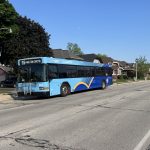Roundabouts Saving Lives
If you picked up a newspaper in Milwaukee in the past month, you would think that roundabouts were a danger to society. Headlines have ranged from “Are roundabouts dangerous? So far, yes” to “Roundabouts take off but still throw drivers a curve.” You would have missed a critical point though, roundabouts are improving safety for those on the roads.
What roundabout is drawing the most ire in the region? Perhaps the first one built in Milwaukee at the south end of the Sixth Street Viaduct? Nope, cars, buses, and trucks sail through that roundabout smoothly. The one at Canal and 25th in the Menomonee Valley after Brewer games? No post-game traffic jams there.
The most hated roundabout in the area lies at the Moorland Road off-ramps on Interstate 43 in New Berlin. The numbers don’t lie, there have been more car accidents at that intersection since the roundabout was implemented.
With 49 crashes at the I-43 and Moorland/Rock Ridge roads roundabout since it opened in November 2007 while still under construction, it’s not a stretch to say things got off to a bumpy start.
…
The old freeway intersection had 29 crashes in nearly eight years before the roundabout, according to New Berlin Police Chief Joseph Rieder. And the Moorland-Rock Ridge roads intersection had 13 crashes between June 2002 and November 2007.
Why have there been more accidents? The most likely reason is the intersection was under construction during a significant portion of that time. Second, and something for which data isn’t readily available, a number of people are likely being introduced to roundabouts for the first time. It would be interesting to see how many of the 49 crashes involved a first-time roundabout driver.
How? Well that’s the simple and thankfully repeatable part, roundabouts work by moving all of the cars in the same direction, eliminating the dangerous t-bone crash.
So while the new roundabout has necessitated the need for a few bumpers to be touched up, it’s eliminated numerous trips to the doctor. And it’s likely the need for bumper repair will fade with time as drivers become more accustomed to the intersections.
Despite NIMBY opposition in suburbs and urban neighborhoods alike, it’s clear roundabouts are an effective way to improve intersection safety for drivers.





















No doubt they are safer as you said. The biggest complaint is how much traffic backs up as a result of uncertainty and confusion regarding how a roundabout works.
Has anyone ever seen the line on the Moorland exit going south 43? During rush hour this strech is a disaster. There is 2 roundabouts within a quarter of a mile.
Hopefully traffic improves with familiarity. Can’t wait till winter…
@Mike I think it’s all about familiarity. Unfortunately that is going to take time to build. Roundabouts becoming of drivers education courses is really a must for the future success of the intersections.
They might be safer for drivers, but I’m not totally convinced that they are better for pedestrians or bicyclists. Crossing the 6th Street roundabout is pretty daunting for a pedestrian. I’d much rather have a 4-way intersection with a walk signal.
@MilwaukeeD Yeah, they’re far from perfect for pedestrians. Bicycles seem to do fine, the one at 25th and Canal works well for bikes. Sixth Street, Moorland, and 25th/Canal aren’t big pedestrian intersections though, so I think a roundabout works well in that space. If you put one at Water and Wisconsin, I think that would greatly hamper pedestrians, but I can’t think of one that the state has placed which damages a pedestrian intersection at this point.
That said, is putting in roundabouts encouraging a driving culture? I don’t know.
I love roundabouts, easy to use and understand. Now, lately people have been expressing concern for large vehicles that travel through roundabouts, and some have been going as far as saying roundabouts are tough for truck drivers. Well, take this from me, I drive an 18-wheeler and like I said above, I love roundabouts;
-roundabouts are infact created with room for large vehicles, thats what the slightly raised either paved or bricked portion is for, called the truck apron. For the off-tracking of trailers.
-if/when I am lost in an area, roundabouts enable me to safely, easily, and quickly do a U-turn.
People need to remember that you must slow and yield to the oncoming traffic. People also need to signal their turns so that the oncoming traffic can move rather than wait and guess what you’re doing. Turnabouts stem from Eruope. There I have never seen a two lane roundabout. Maybe this could be a reason for crashes..people not staying in there lane. Roundabouts are the safest intersections and people need to understand the intent of them. It also keeps traffic flowing smoothly while not having to stop at a stop light which saves on fuel and emissions. Very Eco-friendly to those that are enviromentalist.
frankly the roundabout at moorland and 43 is very confusing. i use the 6th viaduct almost every day and i’ve never seen an accident or been confused as to where or when i should be turning. the moorland rd. roundabout is confusing because there’s no clear “off-ramp” for most people’s destination: the marcus theatre. every time i’ve used it i’ve missed my turn and had to drive up the street and do a u-turn.
You’d have to be an idiot to get in an accident in a roundabout. Amazing.
I’ve just returned from a vacation in Italy, where drivers regard any traffic regulator — red lights, stop signs, lane markers, dangerous curve signs — as mere suggestions… except with regard to roundabouts. They follow the rules of a roundabout so assiduously you’d think they ‘d become Swiss. But that’s the only way the system works.
Roundabouts definitely can improve traffic flow. I recently spent a week with a rental car in Washington D.C. and enjoyed being able to zip through roundabout intersections. Still, if you have a lot of traffic going on one axis, it makes sense to have an over/underpass for two lanes combined with the roundabout. In New Berlin, there’s no real space restrictions, so you can add lanes to a roundabout and until it meets the carrying capacity.
My favorite article about roundabouts: http://www.jsonline.com/news/wisconsin/59094277.html My thought after reading about fears of drunk drivers in roundabouts was – at least we’ll all be safe once the drunk drivers get on I-43 at 70mph!
A more underplayed result of roundabouts is that there is very little to no idling which results in less wasted fuel. This is why I consider roundabouts to have an environmental benefit too.
I’m having a blast in Cairo this week where I’ve only seen 1 traffic signal after two days on the road. EVERYTHING is a roundabout. There are very few left turns – they make you turn right then make a U-turn in a median cut-out.
On the topic of roundabouts, though, I found this collision of two Sheboygan motorcyclists in a roundabout to be timely and topical: http://www.wisinfo.com/apps/pbcs.dll/article?AID=200991012076 Alcohol was involved naturally. No comment on the Sheboygan element.
Although I can understand the concept behind roundabouts regarding less idling time and reduction in T-Bone type crashes, there does not seem to have been much thought given to the needs of large commercial trucks that also need to navigate thru these junctions. When single lane roundabouts are installed at intersections, they invariably do not account for the ‘ off tracking’ requirements of large tractor trailers, who find themselves having to go up on the center perimeter divider in order to make their way thru. As this continues over time, there will inevitably be damage done to these decorative dividers resulting in greater outlays of funding to maintain them. Question; do these center dividers need to be as large as they are?
There are other maintenance and upkeep costs of signalized intersections that just don’t exist with roundabouts, such as electricity and costs for when poles are run down by trucks/cars. While I’m sure some extra landscaping work may be needed every now and then, I doubt the costs really add up.
http://www.dot.state.wi.us/library/publications/docs/pim-4-roundabouts.pdf